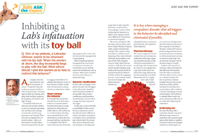Letters: Breed tendency or compulsive disorder?
A reader's response to "Just Ask the Expert: Inhibiting a Lab's infatuation with its toy ball" in the November 2013 issue.
I am a veterinary internist who has owned Labrador retrievers since childhood and read with interest "Just Ask the Expert: Inhibiting a Lab's infatuation with its toy ball" in the June 2013 issue. This was immediately diagnosed as a canine compulsive disorder. But I think this is a breed-related behavior and quite normal in Labrador retrievers.
For generations, Labrador retrievers have been selected for the drive to retrieve, also known as prey drive: Get the bird, bring it back, get the next bird, bring it back. This behavior is easily transferred to toys. In fact, dog trainers seeking good candidates for search-and-rescue and drug or explosive detection get out a tennis ball, toss it, and see how excited a dog gets. Labradors make successful assistants for the disabled because they can be easily trained to retrieve items.

I think this dog just hasn't been trained properly. I'd advise the owners never to accept and then toss the ball from anyplace they don't want play to occur. I know what a slimy, dirt-covered tennis ball feels like when dropped in my clean lap. Even dropping the ball in disgust will reinforce the retrieving behavior. Balls should not be allowed in the house if that is off-limits. Playtime should take place in an acceptable location, and then the ball should be put away until next time. Clever Labradors may go off and select another item (e.g. stick, toy, shoe) to play with, but if ignored the behavior will become extinct. Using a crate to enforce "time out" can be helpful.
This case also illustrates the need for veterinary guidance on our clients' breed selections. Labradors want to get wet and retrieve. Border collies want to stare, nip, and herd. Gordon setters want to run. Border terriers want to dig. Beagles want to bark.
For dogs with true compulsive disorders, the article was otherwise great!
Autumn Davidson, DVM, MS, DACVIM
UC-Davis School of Veterinary Medicine
Davis, Calif.
Dr. Ciribassi responds: Thank you for the thoughtful response. I agree that certain behaviors can be breed-specific in terms of tendencies to engage in the activity. An example is cattle dogs that revert to biting owners' heels in an attempt to prevent them from leaving home; border collies can herd in the same context.
While I agree that these tendencies do tend to follow breed lines, the characteristics that distinguish a compulsive disorder from these breed inclinations is the degree to which the animal engages in the behavior and the ease with which the behavior can be redirected.
In the case of a true compulsive disorder, the behavior will occur often—to the point where most other day-to-day activities are excluded—and it can be difficult to stop it. I think Labs that engage in retrieval as described in the article are beyond normal in this degree of the behavior. I think that your approach to managing the behavior closely resembles how a compulsive disorder would be approached.
Remember also that behavior is never black-and-white or off-and-on. It is always several shades of grey (no reference to a popular book intended), and the challenge with this specialty is determining what end of the spectrum the patient is leaning toward.
John Ciribassi, DVM, DACVB
Chicagoland Veterinary Behavior Consultants
Carol Stream, Ill.